| Anatomy, Skin (Integument) | ||
| 1 | How many organ systems are there in the human body? | Answer |
| 2 | Can you name the organ systems of the human body? | Answer |
| 2 | Anatomy Skin integumentary Quiz | Answer |
| Skin Diseases | ||
| 1 | What are various examples? | Answer |
| 1 | Permanent & Temporary Skin Disorders: How To Manage | Answer |
| 19 of the Most Common Skin Conditions: Photos & Treatments | ||
| 1 | What are various examples? | Answer |
| Dermatologist | ||
| 1 | What is a Dermatologist? | Answer |
| 1 | What do dermatologists do? | Answer |
| 1 | What types of conditions do dermatologists treat? | Answer |
| 1 | What types of procedures do they do? | Answer |
Anatomy, Skin (Integument)
|
How many organ systems are there in the human body? 11 Can you name the organ systems of the human body? Anatomy Skin integumentary Quiz
|
19 of the Most Common Skin Conditions: Photos & Treatments
|
1. Acne (Acne vulgaris) 2. Atopic dermatitis (Eczema) 3. Shingles (Herpes Zoster) 4. Hives (Urticaria) 5. Sunburn 6. Contact Dermatitis 7. Diaper Rash 8. Rosacea 9. Athlete's Foot (Tinea Pedis) 10. Tumor 11. Hair Loss 12. Viral warts 13. Vitiligo 14. Skin lesions 15. Skin rashes 16. Discoloration or pigmentation 17. Raised bumps that are red or white 18. A rash, which might be painful or itchy 19. Scaly or rough skin. |
44 Common Skin Disorders
|
Permanent & Temporary Skin Disorders: How To Manage
|
Permanent & Temporary Skin Disorders: How To Manage
Permanent Skin Disorders 1. Seborrheic Dermatitis 2. Moles 3. Melanoma 4. Rosacea 5. Lupus 6. Psoriasis 7. Eczema/Atopic Dermatitis 8. Vitiligo Temporary Skin Disorders 1. Acne 2. Sunburn 3. Contact Dermatitis 4. Cold Sores There are hundreds of skin conditions that affect humans. The most common skin conditions can have some symptoms that are similar, so it is important to understand the differences between them. People should work closely with a dermatologist to diagnose and treat any skin condition to ensure that their lifestyle is not affected. Below are the most common skin diseases separated by type. Permanent conditions A number of skin conditions last a long time. Some may start in childhood and continue into adulthood. In some cases, the condition will not always be present but will flare up at certain times. 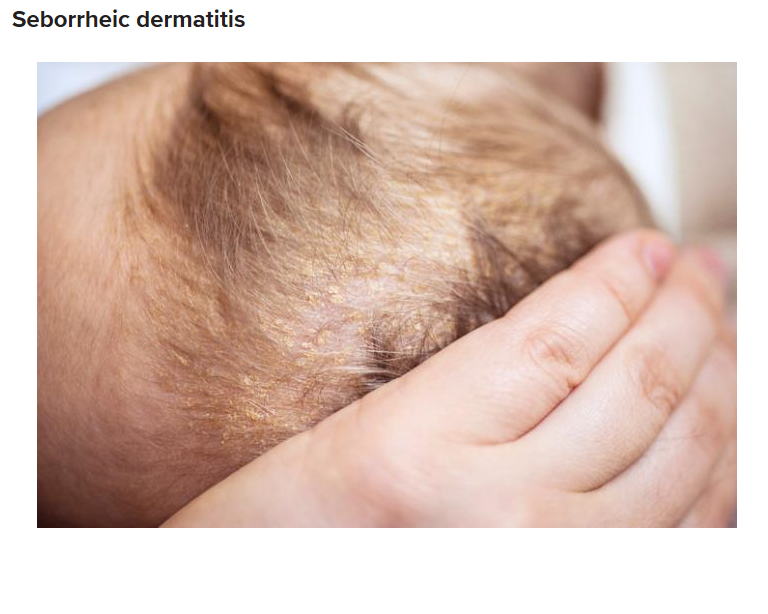 In babies, this is commonly known as cradle cap. Greasy and scaly patches of skin form on the baby’s skin, most commonly on the scalp. It is harmless and usually goes away on its own. In adults, seborrheic dermatitis may appear anywhere, and is prone to flare up and disappear for the rest of a person’s life. The affected skin may be reddish, swollen, and appear greasy. A white-to-yellow crust may appear on the surface of the skin as well. Many treatments help to bring relief from symptoms. 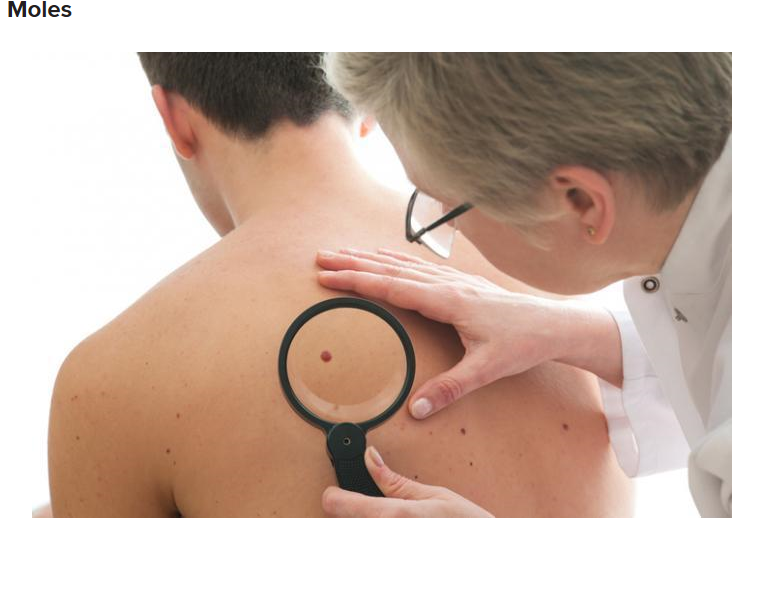
Common growths on the skin that appear when the skin cells bunch up with tissue surrounding them. Most people have moles and may develop new ones from time to time. Moles have no symptoms, but should be regularly checked if they grow larger, appear abnormal, or change in color. 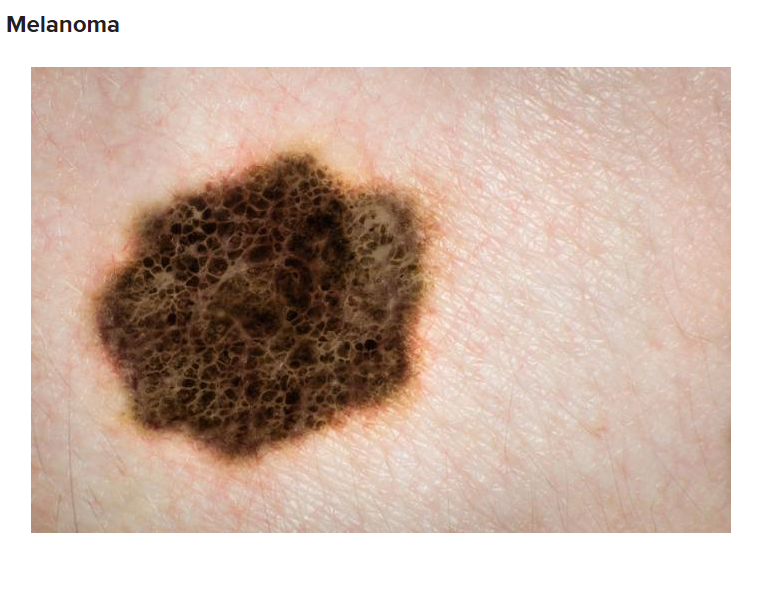 Abnormal moles may lead to melanoma, a serious and life-threatening skin cancer. If moles have asymmetrical shapes, ragged edges, uneven colors, or change in size, they should be checked. Patients with melanoma may have surgery, or undergo chemotherapy or radiation treatments. 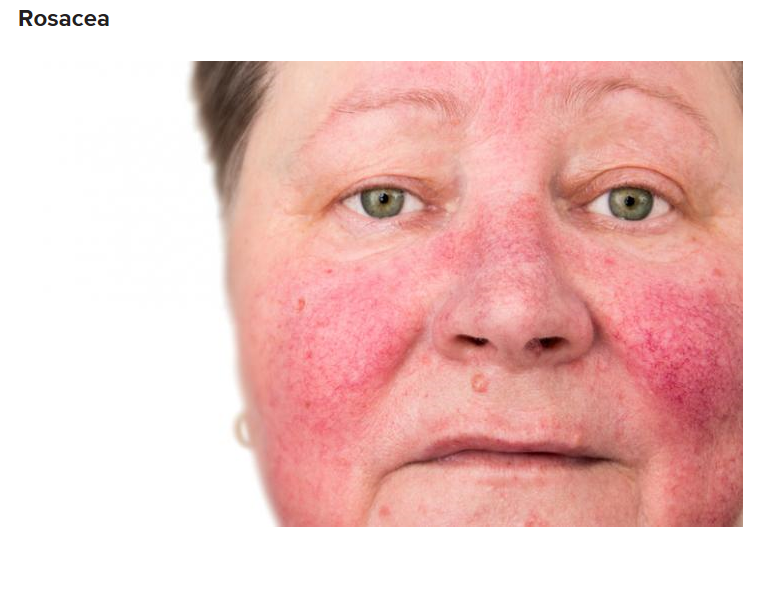 The skin condition rosacea is most commonly associated with redness. However, there are four subtypes that cause other symptoms as well: Erythematotelangiectatic rosacea causes the typical redness, visible blood vessels, and flushing. Ocular rosacea can cause red and irritated eyes, swollen eyelids, and symptoms that look like a stye. Papulopustular rosacea causes redness, swelling, and is accompanied by breakouts that look like acne. Phymatous rosacea causes the skin to thicken and have a bumpy texture. There is no known cure for rosacea, but symptoms can and should be treated to keep the condition in check. Lupus Lupus is a complex disorder that varies from person to person. The disease attacks the immune system, causing inflammation and pain. While lupus can affect any part of the body, symptoms on the skin include red patches or ring shapes on the skin, sunburn-like rashes on the nose and cheeks, or circular rashes that don’t itch or hurt. These may be accompanied by other symptoms, such as headaches, fever, fatigue, and swollen, stiff, or painful joints. Treatment includes various strength medications designed to help minimize the damage caused by lupus. Psoriasis 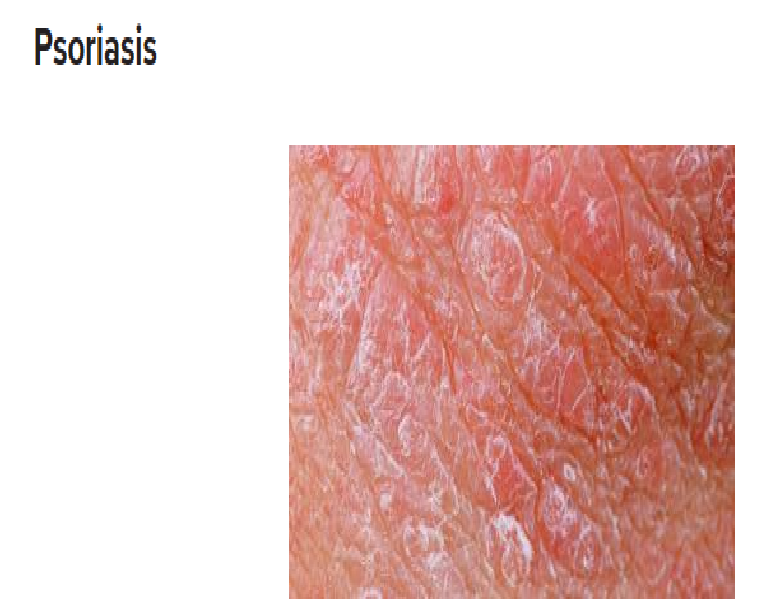 Psoriasis is an autoimmune disorder. Symptoms typically include patches of abnormal skin. The affected skin is typically red, scaly, and very itchy. The affected areas vary in size and severity. There are five main types of psoriasis: Plaque psoriasis causes thick red patches of skin. Pustular psoriasis causes pustules surrounded by red skin. Erythodermic psoriasis causes patches of skin that look like severe burns covering large portions of the body. Inverse psoriasis causes a shiny red rash in the folds of the skin. Guttate psoriasis causes small red spots on the scalp, face, torso, and limbs. Eczema 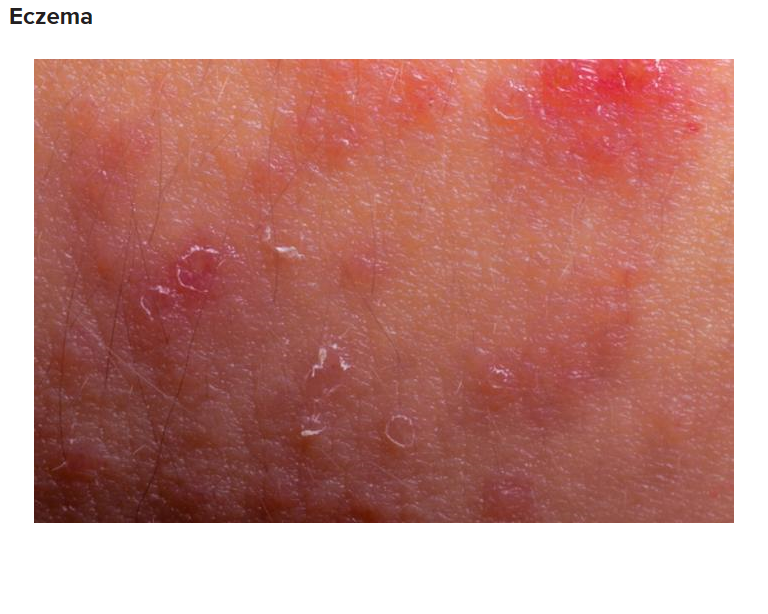 The condition is commonly found in infants and young children, though it continues into adulthood as well. Symptoms include rashes on the face, scalp, behind the elbows, or on the neck, wrists, ankles, or legs. The rashes are very itchy and may become bumpy, change color, or thicken. In adults, the rashes may cover more of the body, causing very dry skin that is permanently itchy. There are a few different types of eczema, each causing their own symptoms. There is no known cure for eczema. It either clears up on its own or the symptoms are treated with medications and creams. Vitiligo 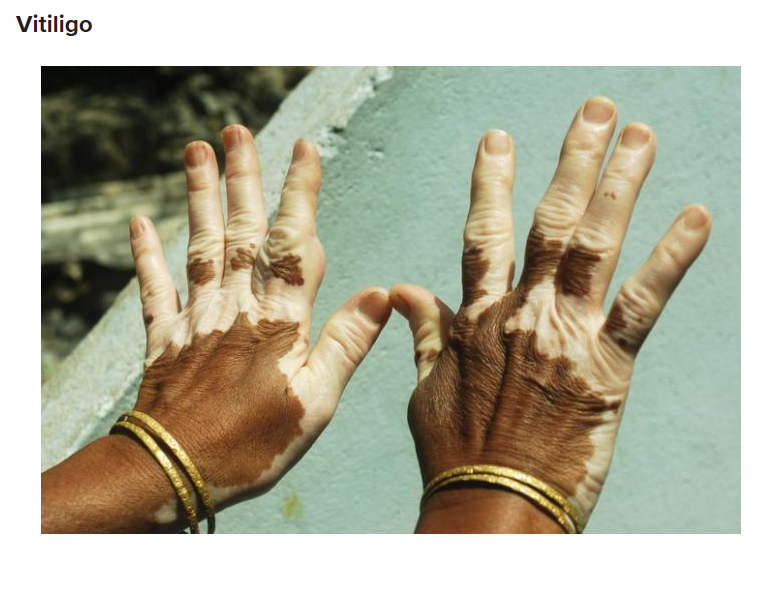 Vitiligo is the loss of pigmentation in the skin. White patches of skin are the main symptom of vitiligo, and more commonly appear in areas where the skin is exposed to sunlight. People with vitiligo often lose their hair color early as well. For some people, the symptoms are in one area, while others find that it spreads slowly over many years. There is no known cure for vitiligo. There are some medical and surgical treatment options, though they are not right for everyone. Temporary conditions a close up of acne on a persons right cheekShare on Pinterest Acne is a widespread temporary skin condition that may be treated with creams or medication. Acne One of the most widespread skin conditions, acne comes in many forms. Pustules are the common red pimples that have pus at their tips. Papules are the raised red bumps caused by infected hair follicles. Nodules are the painful lumps that lie underneath the surface of the skin. Cysts are the typically larger painful, pus-filled infections that lie beneath the skin. All types of acne are commonly treated with creams, and sometimes medication is necessary. Hives Hives are itchy welts that are raised up from the normal layer of the skin. They may be caused by an allergic reaction in the body or outside factors, such as stress, illnesses, or even tight clothes. Hives are treated with antihistamines and preventive practices. Warts The common raised bumps on the skin known as warts are actually caused by the human papillomavirus (HPV). Warts are contagious, and can appear on any part of the body. Common warts typically grow on the hands, feet, and joints, though they can appear anywhere. They often go away on their own, though unsightly warts can be treated with liquid nitrogen or medicated creams. Fungal nail infection A condition in which fungus lives near, under, and around the nails, usually in the feet. The fungal buildup causes the nail’s edges to crumble away, producing white-yellowish scaling and flaking on the surface of the nails. Treatment is usually an anti-fungal cream or other fungal treatment. Cold sore A cold sore is a red, fluid-filled blister usually found near the mouth. The sore itself is painful or delicate. Other symptoms include itching or burning sensations on the site before the sore is visible. Cold sores are caused by the herpes simplex virus, and there is no known cure for the virus. The sores may return and last for up to 2 weeks. Medical treatment includes creams and medications. Candidiasis The overgrowth of the Candida albicans fungus on the body is called Candidiasis. This causes irritated patches of skin, usually found in the armpits, groin, or under folds of skin such, as the knee. Candidiasis can usually be prevented with home remedies, proper hygiene, and avoiding the overuse of antibiotics. Athlete’s foot A rash caused by a fungus that rapidly multiplies in warm, damp conditions, such as athletic shoes. Symptoms include dry, itchy, red skin. The skin between the toes or under the foot may be soggy, white, cracked, or scaly. It often itches and causes soreness. The problem usually arises quickly. Athlete’s foot is treated with medicated ointments and good foot hygiene Internal conditions Carbuncle When Staphylococcus aureus bacteria make their way into the hair follicles and cause an infection, a carbuncle is produced. This is a red, irritated lump underneath the skin. Carbuncles can be nearly any size, and the lump quickly fills with pus and becomes swollen. Other symptoms include tiredness, itching on the site of the lump, and fever. Carbuncles are treated with antibiotics, drainage, and antibacterial washes. Carbuncles usually respond well to medical treatment. Cellulitis A bacterial infection in the deeper layers of the skin, which develops quickly and can spread rapidly throughout the body. An area of the skin may become red and swollen, and feel hot, painful, and tender to the touch. It is most common in the legs, but can occur everywhere. Severe infections may be life-threatening. Most cases are treated with antibiotics. Age-related conditions There is a wide range of skin diseases and they can affect people of all ages. In children Measles Measles mostly affects children and pregnant women, and symptoms may be a brown or red rash. Hemangiomas Hemangiomas are most common on the neck, head, or face of infants. They begin as small red scratches or bumps which eventually begin to bulge out and turn into large growths. Although hemangiomas are easily discovered on the skin, they can actually be found on various organs of the body, and are commonly discovered on the liver. They usually disappear on their own by the age of 10, though some may need removal. Measles A highly infectious airborne viral illness. Children and pregnant women are most vulnerable to the illness, but it can happen to anyone. One symptom of measles is a red or brown rash that spreads down the body. Other symptoms include fever, runny eyes and nose, cough, and small reddish spots inside the mouth. Measles tend to go away after 7-10 days, but symptoms may still be treated. Impetigo A common and contagious infection of the skin. It is one of the most common skin infections in young children and usually causes itchy sores and blisters to appear around the mouth and face. These sores then burst and leave a crust. This crust then dries out and leaves a red mark that fades without scarring. The whole process usually takes 3 weeks without treatment. With treatment, the process is reduced to 1 week. Dermatomyositis Dermatomyositis is a rare inflammatory skin disease most common in children ages 5 to 15 and adults between 40 and 60. Common symptoms include a red-to-purple rash on the chest, face, nails, or elbows, as well as muscle weakness and swelling. There is no cure for dermatomyositis, but treatments aim to manage symptoms. In adults Shingles (herpes zoster) Shingles is caused by the return of the infection that causes chickenpox. It most commonly occurs in the elderly, but can affect anyone. It starts with a painful sensation in the body and is followed within 2 days by a reddish, blistering rash that is widespread on the surrounding skin. Antiviral treatment within the first 48 hours after the eruption can help limit the pain. Vaccines are said to help prevent shingles. Seborrheic keratoses These are harmless bumps that commonly show up on people as they age. They may appear as black, dark brown, or sometimes yellow bumpy patches of skin that can look like they are stuck to the skin. Seborrheic keratoses are sometimes confused with skin cancers, though they themselves have no medical significance. Any spots that doctors are uncertain about should be tested. Age spots Age spots or liver spots are flat spots on the skin with more pigment than the surrounding area. This may be caused by prolonged exposure to the sun over the years. These spots cause no symptoms themselves, but most patients do not like their appearance. They can be treated in a variety of ways, but medical treatment is not necessary. According to dermatology, there are two kinds of skin disorders – temporary and permanent. While the former can be treated through various options, the latter can recur on and off and may need medication for a lifetime. Main Causes Of Skin Disorders Permanent Skin Disorders Temporary Skin Disorders Main Causes Of Skin Disorders Skin problems that occur very commonly are acne, rosacea, rashes and moles. Some like acne can be treated, while others like moles may need medical attention. Conditions like rosacea and eczema [1] are permanent. The causes of these disorders can range from blocked pores and over-active sebaceous glands leading to acne, bacterial infections and even genetic disorders. Some skin disorders like lupus are due to an autoimmune disease. Permanent Skin Disorders There are some skin conditions that can last a lifetime. Most have a pattern of flaring up due to triggers and then subsiding before disappearing. Others, like vitiligo are permanent and can only be managed, not completely treated. Here are the most common ones: 1. Moles And Melanoma These are growths that can appear anywhere on the skin when skin cells and tissues bunch up. They are very common. Abnormal moles can lead to melanoma [2], a serious form of skin cancer. Severity: Most moles are harmless unless one picks on them or if there is an injury and consequent infection. If a mole changes colour, shape, size and is unevenly red or brown, or appears abnormal, it needs to be checked by a dermatologist. Treatment Options: Moles can be removed with laser treatments. Larger moles need to be removed surgically. Topical creams can diminish and eradicate moles, but they work slowly. Melanoma might need surgery or other related cancer treatments. 2. Lupus Lupus is an autoimmune disease that can affect any part of the body. When it affects the skin, it leads to a red, butterfly shaped rash on the cheeks which is not itchy or painful. Severity: The rash on the skin may be one of the signs; joint pains, inflammation and fatigue are other symptoms. Since lupus patients are photo-sensitive, being in the sun can aggravate the rash. Treatment Options: Anti-inflammatory and non-steroidal medication is usually prescribed. For the butterfly rash, a topical anti-inflammatory immunosuppressant cream and a sunscreen with high SPF is prescribed. 3. Eczema/Atopic Dermatitis Different types of swelling on the skin are classified as Eczema. Symptoms include dry, itchy or scaly skin and rash on the face or on the wrists and ankles. It is not contagious, but its causes are unknown. The most common form is known as atopic dermatitis. Severity: Scratching the itchy skin can make it worse and lead to inflammation. It can get healed over time, but needs to be managed. People with eczema often suffer from asthma as well in some cases. Treatment Options: Treatments include dermatologist prescribed medicines, skin creams to control the itching and a strict skin and hair care regimen. The use of hypoallergenic products for the skin and hair are recommended. 4. Rosacea Rosacea [4] is a skin condition commonly affecting women more than men. Its causes are attributed to immunity issues, veins and the environment. The skin goes red and at times is accompanied with inflammation and pimples. Severity: One type of rosacea causes swollen eyelids, with symptoms similar to a stye. Another causes the typical redness associated with rosacea. Other forms of rosacea include swelling, breakouts and thickening of the skin. Treatment Options: There is no known cure for rosacea. But antibiotics like doxycycline or a metronidazole cream prescribed by a dermatologist can be used. Other topical treatments are also available. 5. Seborrheic Dermatitis Seborrheic dermatitis [5] can affect babies, children or adults. It is known as cradle cap in babies where scaly patches are formed on the skin, mostly on the scalp. In adults, it can appear anywhere and flare up at any time. Severity: When seborrheic dermatitis affects babies, it is known to disappear on its own. With adults however, the affected part of the skin or scalp is greasy, swollen and reddish. It can even have a pale yellow crust and can flare up anytime. Treatment Options: Topical treatments like selenium sulphide, or shampoos containing ketoconazole or pyrithione zinc are prescribed. A dermatologist might even prescribe topical corticosteroids based on the severity of the condition. 6. Psoriasis Psoriasis [6] is a permanent and autoimmune disorder. Scaly and itchy red patches that can occur anywhere on the body in this condition. Known to affect children, it can continue into adulthood. Severity: The rash varies from a shiny red one to pustules. It occurs mostly on the face and neck, arms, ankles and scalp. It can change colour and cause extremely dry skin, which is often itchy. Treatment Options: The treatment options only help to manage the condition; though it may clear up on its own. Topical creams and medication prescribed by a dermatologist help to control psoriasis. 7. Vitiligo When the skin loses its pigmentation, it leads to vitiligo [7]. It is a permanent condition when the skin cells that make colour are attacked and destroyed. The skin turns white as a result. It affects the hair as well sometimes. Severity: The white patches appear more commonly where there is sun exposure, and it can spread slowly over the years. In extremely severe cases, the skin loses its pigment all over the body and hair. Treatment Options: There is no known cure for vitiligo till date. There are a few medical and surgical procedures, which may not suit everyone. Some treatments help in offering a more even skin tone. Temporary Skin Disorders 1. Acne Acne is one of the most common and temporary skincare conditions. It can occur due to excess oil and sebum production, blocked pores and sometimes even diet. Severity: Acne can lead to pimples that have pus in them. Infected hair follicles and nodules (painful bumps under the skin) are forms of acne. The larger pimples, often painful and full of pus, are known as cysts Treatment Options: Most acne can be treated with topical creams, lotions and regular use of toners. In some cases, medication may be necessary. Dark red acne often requires a change in diet with reduced consumption of meat. 2. Sunburn This is a skin condition that usually occurs when the skin is exposed to the UV rays of the sun. The skin turns red and looks burnt. It can largely be prevented by avoiding exposure to the sunlight. Severity: Sunburn can get quite painful as the skin dries out and tightens up. It also turns red and is painful to touch. It peels away as the condition improves, but that is painful too. Treatment Options: Treatment includes a shower with cold water, drinking plenty of fluids, aloe vera gels or non-oily moisturisers. Cold milk applied on the skin is also an effective home remedy. 3. Contact Dermatitis Though it is a form of eczema, contact dermatitis is a temporary skin condition. It can occur due to contact with plants like oaks and poison ivy. Even irritants such as bleach or chemicals in detergents can cause it. Severity: It can lead to itchy or red skin that starts in one part of the body and spreads all over like an allergic reaction. In severe cases, there is blister formation, itching and even swelling in extreme cases. Treatment Options: Antihistamines and oral or topical steroids are usually prescribed to treat this condition. Oatmeal baths or a shower with an oatmeal soap also helps as does the application of a calamine lotion. 4. Cold Sores A cold sore is a type of blister, red and full of fluid, commonly found in the region of the mouth. It is painful to touch and can last for up to two weeks. It is caused by the herpes simplex virus. Severity: A cold sore can be very painful and usually comes with a burning sensation in the affected area. Sometimes, it can even be itchy. They can recur and last for a long time. Treatment Options: There is no known cure for the herpes simplex virus that causes cold sores. Treatment includes the use of topical cream and prescribed medicines for relief. If a skin condition you have is temporary, it is best to have it treated as soon as possible. However, if it is a permanent condition, avoiding triggers and seeing a dermatologist for the right treatment option goes a long way in managing the disorder. |
Dermatologist
|
What is a Dermatologist? Dermatologist: A dermatologist is a physician who is trained to evaluate and manage pediatric and adult patients with benign and malignant disorders of the skin, hair, nails and adjacent mucous membranes. A dermatologist has had additional training and experience in the following: The diagnosis and treatment of skin cancers, melanomas, moles, and other tumors of the skin. The management of contact dermatitis and other inflammatory skin disorders. The recognition of the skin manifestations of systemic and infectious diseases. Dermatopathology. Surgical techniques used in dermatology. Dermatologists also manage cosmetic disorders of the skin, including hair loss, scars, and the skin changes associated with aging. Dermatopathologist: A dermatopathologist is expert in the microscopic diagnosis of diseases of the skin, including infectious, immunologic, degenerative, and neoplastic diseases. This entails the examination and interpretation of specially prepared tissue sections, cellular scrapings, and smears of skin lesions by means of light microscopy, electron microscopy, and fluorescence microscopy. Pediatric Dermatologist: A pediatric dermatologist is a dermatologist who has additional training and expertise in the evaluation and management of skin diseases which occur more commonly or exclusively in children. Examples include: all types of birthmarks, neonatal dermatology, genodermatoses, pediatric infections or inflammatory processes and skin diseases in children with complex medical conditions requiring coordinated multispecialty care. What do dermatologists do? A dermatologist’s work can typically be divided into three areas. These include: Medical. A dermatologist can diagnose and treat conditions that affect your skin. This includes conditions like plaque psoriasis, rosacea, and acne. A dermatologist can also identify symptoms on your skin that could be signs of other health conditions. For example, itchy, dry skin can sometimes indicate problems with your kidneys. Surgery. Many dermatologists do minor surgery, like removing moles or warts or doing skin biopsies. Other dermatologists will specialize in more extensive surgery. These procedures can include removing benign cysts or skin cancer. Cosmetic. A dermatologist can treat skin issues that affect your appearance. This may include hair loss, dark spots, or wrinkles. Many dermatologists are trained to administer cosmetic treatments, too. These include fillers, chemical peels, and laser hair removal. What types of conditions do dermatologists treat? Dermatologists can treat thousands of conditions that affect your skin, hair, or nails. A few of the most common conditions they treat include: Acne. Based on the severity of your acne, a dermatologist can treat this condition with topical treatments, medication, lasers, or other light therapies, chemical peels, or by removing large cysts. Skin cancer. Skin cancer can occur anywhere on your body. A dermatologist can remove cancer cells and monitor you to make sure it doesn’t return. Dermatitis. Dermatitis encompasses several types of skin conditions that cause inflammation and irritation. This may include eczema, cradle cap, and allergic reactions. Infections. Viruses, bacteria, fungi, and parasites can all find their way into your skin and cause a variety of skin infections. A dermatologist can help diagnose the cause of infections and prescribe treatment. Hair loss. Hair loss may be caused by hereditary baldness. Conditions like stress, illness, and hormonal changes may also impact hair loss. A dermatologist can determine the underlying cause and help treat it if possible. Nail problems. Spots, discoloration, and nail separation are common nail issues that are treated by dermatologists. What types of procedures do they do? Dermatologists can perform a wide variety of procedures, from minor ones like skin tag removal to more involved ones, like skin cancer surgery. Some procedures that dermatologists regularly do include: Biopsies. A dermatologist can perform different types of biopsy procedures to diagnose or rule out skin cancer or other conditions. Laser therapy. Laser therapy treatments may be used to remove warts, moles, sun spots, tattoos, acne scars, blemishes, wrinkles, or unwanted hair. Surgical excision. A dermatologist may perform a surgical excision to remove growths like moles, skin tags, and lesions. This is usually done with local anesthesia so you don’t feel pain. Cryotherapy. Cryotherapy is a unique treatment that involves controlled exposure to extremely cold temperatures. It can be used to treat skin conditions like warts, skin tags, and some tumors. Sclerotherapy. Sclerotherapy is a procedure that helps treat spider and varicose veins. It involves injecting chemicals into damaged veins which help to diminish the appearance of these types of veins. Mohs surgery. This type of skin cancer surgery removes thin layers of tissue around a tumor. Between each removal, the doctor examines the skin for signs of additional cancer cells. When no more cancer cells are found, they stop removing tissue. Chemical peels. Chemical peels remove damaged skin. Peels can help rejuvenate new skin and reduce signs of aging. Cosmetic injections. A dermatologist can help diminish the appearance of wrinkles and sagging skin by injecting Botox or fillers during an office visit. Dermabrasion. This exfoliating technique can reduce the appearance of fine lines, age spots, acne scars, and precancerous skin patches. Tumescent liposuction. Dermatologists use liposuction to remove unwanted fat from targeted areas of your body. |
